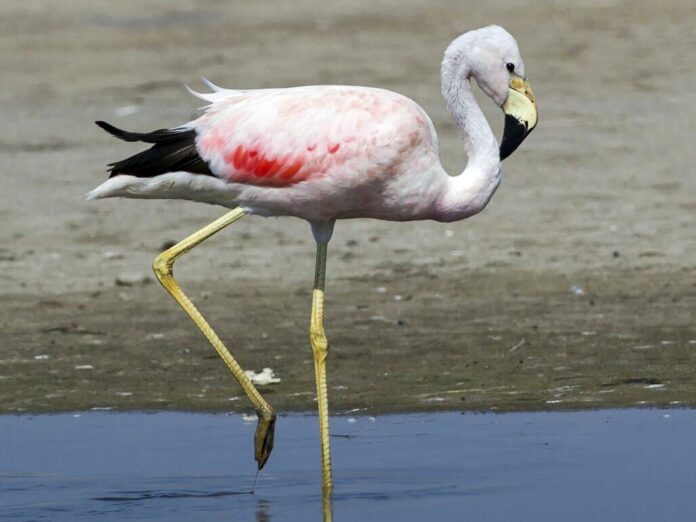You’re out on a nature walk, and you see a bright pink bird, but you’re not sure if it’s a flamingo or some other type of bird. Without knowing the distinguishing features of all six species of flamingos, you might not be able to identify the bird you saw.
Even though there are only six species of flamingos in the world, birders and non-birders can easily identify these flamboyant birds. Flamingo species are some of the most unique and easily recognizable birds globally.
With this handy list of all six species of flamingos, you’ll never have trouble identifying these beautiful birds again. You’ll learn all the six species of flamingos, along with some of their identifying characteristics.
Characteristics of Flamingo Species
Appearance
One of the most distinctive features of the flamingo is its pink or reddish coloring. These bird species are not born pink, instead, food turns feathers pink. The coloring comes from beta carotene pigments in their food, like shrimp or plankton. The brightness of the flamingo’s color also depends on how much of these carotenoid pigments they consume.
Flamingo feather coloration ranges from pale pink to crimson depending on the flamingo species. These wading birds have long, stilt-like legs that allow them to wade in deep water to look for food. They’re often spotted standing on one leg, especially when sleeping. They’re also known for their long, S-shaped necks and strongly hooked bills adapted for catching prey more easily.
Habitats
Flamingoes are always found around water sources. Although they can swim quite well, they often walk through water as they feed, bending their necks downward to reach the water. While feeding, flamingos strain water through the lamellae in their bills to filter out insects, brine shrimp, algae, and other food.
Diet
A flamingo’s diet consists of algae and small crustaceans. They often live in salty, alkaline habitats that aren’t suitable for many species, with the exception of algae, diatoms, and crustaceans they feed on. They have distinctive eating habits. They feed by holding their large bill upside down in the water.
They suck in water and mud at the front of the bill and then pump it again at the sides. The briny plates in their bill act like tiny filters, trapping shrimp and other small water creatures for the flamingo to eat. Because all birds love water, you can attract flamingos by having some bird bath fountains in your home.
They feed their young hatchlings crop milk. While not the same as milk produced in the mammary glands, crop milk is a highly nutritious substance that nourishes very young flamingos before they begin to feed themselves. Pigeons, doves, and some penguins also produce crop milk for their chicks.
Social Structure
Flamingos are very social birds. Flamingos live in groups called colonies, or flamboyance. These groups range from a few pairs to tens of thousands of flamingos. These colonies are believed to help flamingos avoid predators, maximize their food intake, and use scarcely suitable nesting sites efficiently.
They’re also very noisy birds and communicate by honking loudly. They use vocalizations and displays to communicate with each other. Colonies will perform ritualized flamingo displays to stimulate hormone production, and most adult birds will breed. Their vocalization sounds include growling, low babbling, and nasal honking.
Why are Flamingos Pink?
Flamingos are known for their pink plumage, but not all flamingos are pink. The pink coloration comes from the carotenoid pigments in the bird’s diet. When there is a lack of this pigment, the birds will be gray or white. Depending on what the birds eat, they may also have orange feathers, and many flamingos have some black on their wings.
Tales of blue flamingos are not true, but you can come across a single black flamingo. Black flamingo is not a new species, and it has been spotted twice, once in Israel and once in Cyprus.
Types of Flamingo
While there are six recognized flamingo species today, at least ten flamingo species have been identified through fossil remains. Here are six flamingo species that are very common:
Chilean flamingo (Phoenicopterus chilensis)
The Chilean flamingo is also related to the Greater flamingo. Their color is not as bright as the American flamingo, and it stands out with its grayish-colored legs and pink joints. It has a large black portion on its bill. This flamingo species is native to South America in countries like Peru and Chile.
It has also been transported to locations in Germany and parts of California. This species of flamingo has been held in captivity, and approximately 400 have grown up in Zoo Basel in Switzerland, where the first Chilean flamingos were raised in captivity and transported to Zoos worldwide.
Andean flamingo (Phoenicoparrus andinus)
The Andean flamingo is a species of flamingo found in the high-altitude wetlands of the Andes Mountains. It is the only flamingo species that live in a temperate climate. These species stand out because of their yellow legs and pale pink colors. Andean flamingos are vulnerable to extinction according to the IUCN list of Threatened Species.

James Flamingo
The James’s flamingo, also known as Puna flamingo, is found in the same general area in South America, mainly in Peru, Chile, and Argentina. It is the largest species of flamingo and inhabits brackish lakes with hot springs in the high altitudes of the Andes. Its plumage is pale pink with whitish streaks, and its legs are bright red.

Lesser Flamingo
The lesser flamingo is a small species of flamingo that inhabits shallow lakes and mudflats in Africa, India, and southern Asia. Lesser flamingos are the smallest flamingo species, only reaching about 3 feet tall, although they may be the most numerous, with upwards of two million birds. Lesser flamingos are considered near threatened due to the substantial drop in population over the recent years.

Greater Flamingo
The greater flamingo is the tallest of the flamingo species, reaching up to 70 inches. They inhabit brackish wetlands in Africa, southern Europe, the Middle East, and India. Their color stands out as more pinkish-white than the American flamingo, which is more pinkish.

These species prefer mudflats and saltwater lagoons, where they search for food like shrimp, mollusks, and algae in the mud. They’re adaptable to living in captivity, and they have an average lifetime of 60 years in captivity. The oldest known Greater flamingo lives in Australia at Adelaide Zoo and is 77 years old.
American Flamingo
The American flamingo, also known as the Caribbean flamingo, is a medium-sized bird measuring about 55 inches tall. The American or Caribbean flamingo is native to Mexico, the Caribbean, and the northernmost tip of South America. Its plumage is pink with white streaks, and it has black wingtips. The legs of American flamingo or Caribbean flamingo are long and thin, and the bill is curved.
This Caribbean flamingo lives in the Galapagos Islands, Cub, Colombia, Venezuela, and other close islands since it prefers lagoons and inland lakes. Although they have been spotted in Southern Mexico, the Everglades, and other locations in Florida that match their preference. American flamingos are good swimmers and often travel in flocks.
FAQs on the List of Flamingo Species
Why do flamingos make each other bleed?
When the two flamingos feed a chick, there is always blood or red liquid, the crop milk. Parent flamingos produce crop milk in their digestive tracts and regurgitate it to feed young ones.
Do flamingos lay eggs?
Flamingos build nests that look similar to mounds of mud along waterways. At the top of the mound, the female lays one egg in a shallow hole. The parents take turns sitting on the egg to keep it warm. Just like you see in various photo gallery of wild bird nests and eggs, the baby flamingos are able to grow and adapt while not being endangered.
Where do flamingos sleep?
They sleep with their heads on their backs and often rest by standing for long periods on one leg. Birds lose body heat through their limbs, so by standing on a single leg and tucking the other leg under their belly, they limit the amount of heat that escapes through their legs and feet.
Where do flamingos nest?
Little grey baby flamingo hatch atop a mud mound after about 28 to 32 days of incubation. Both parents help feed their chicks a diet rich in beta-keratin by “milking” it from the lining of their crops.
Final Thought on the Flamingo Species
Flamingos are beautiful birds that have an interesting set of behaviors and adaptations. These birds are one-of-a-kind, from their long necks to their single-legged sleeping. Despite their noisy nature, they are so attractive that you can watch them all day long without getting tired.
The post Flamingo Species List appeared first on Kitchen Infinity.
kitcheninfinity.com









